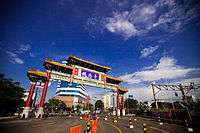Chinatowns in Asia
| Chinatown | |||||||
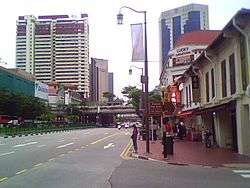 Singapore Chinatown | |||||||
| Chinese | 唐人街 | ||||||
|---|---|---|---|---|---|---|---|
| |||||||
| Alternative Chinese name | |||||||
| Traditional Chinese | 中國城 | ||||||
| Simplified Chinese | 中国城 | ||||||
| |||||||
| Second alternative Chinese name | |||||||
| Traditional Chinese | 華埠 | ||||||
| Simplified Chinese | 华埠 | ||||||
| |||||||
| Chinatowns |
|---|
Chinatowns in Asia are widespread with a large concentration of overseas Chinese in East Asia and Southeast Asia and ethnic Chinese whose ancestors came from southern China - particularly the provinces of Guangdong, Fujian, and Hainan - and settled in countries such as Brunei, Cambodia, Indonesia, India, Laos, Malaysia, Myanmar, Singapore, the Philippines, Taiwan, Thailand, Vietnam, Japan and Korea centuries ago—starting as early as the Tang Dynasty, but mostly notably in the 17th through the 19th centuries (during the reign of the Qing Dynasty), and well into the 20th century. Today the Chinese diaspora in Asia is largely concentrated in Southeast Asia however the legacy of the once widespread overseas Chinese communities in Asia is evident in the many Chinatowns that are found across East, South and Southeast Asia.
These ethnic Chinese arrived from southern mainland China and were mainly Chinese people of Cantonese (Vietnam), Hakka (India, East Timor, Bangladesh, Malaysia, Singapore, Indonesia, Thailand, Burma / Myanmar, Brunei), Hokkien (Philippines, Singapore, Malaysia, Indonesia, Brunei, Myanmar), and Teochew/Chaozhou (Cambodia, Laos, Thailand, Vietnam ) stock and pockets of Hainanese, Hokchew and Henghwa in some countries.
The largest Chinatown in Asia is located in Yokohama, Japan. (See Yokohama Chinatown). These early groups did not identify as hailing from Mainland China, but from their subregion of origin; for example, the Cantonese did not relate to the Hakka people.
Binondo, located in Manila, Philippines is considered by many to be the oldest existing Chinatown in the world, having been officially established in 1594 by the Spanish colonial government in the Philippines that set off the area as a permanent settlement for Chinese who had converted to Christianity. (A separate area, then called the Parian, was allotted for unconverted Chinese.)[1]
The ethnic Chinese represent a large minority population in most of these countries—with Singapore being the exception where Chinese-origin Singaporeans form the majority of the population. Chinese Indonesians and Chinese Filipinos have adopted to Indonesian and Filipino ways, respectively. Thai Chinese have generally assimilated into the larger Thai population.
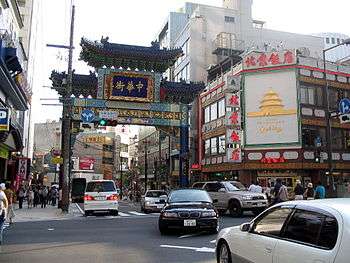
Specific Asian Chinatowns
Cambodia
Phnom Penh's Chinatown is on Street 136.
Cambodia experienced ethnic Chinese settlement beginning in the 15th century. In recent decades, a large number of new and more recent Mainland Chinese immigrants have immigrated to Cambodia. Several Cambodian cities are known or suspected to have started out as Chinese settlements.
India
Most of the Chinese of Calcutta live in or near is a Chinatown in Calcutta. Many Hakkas live in a community known as Tangra, which is dominated by leather tanneries (the Hindu majority will not touch cattle) and Chinese restaurants. Another Chinatown is in Byculla, Mumbai; however it has diminished in population as many of its Indian-born Chinese ethnic residents have migrated, mainly to major immigrant destinations such as Australia, Canada and the United States.
Indonesia
In Indonesia, many Chinese living within city centre and mostly living in big cities in Java, Sumatra, and Kalimantan Island. There are also has large Chinese population in small towns or villages in Sumatra and Kalimantan.
In Java Island, especially in Jakarta, the Chinese resided in Northern part of the province, such as Glodok, Mangga Dua, Pinangsia, Grogol, Pantai Indah Kapok, and Pluit. Other Chinatown in Java island are in Tangerang city center, Jalan Pekojan in Semarang, Lasem in Central Java, and Kya-Kya in Surabaya.
As for Sumatra and Kalimantan island, Many cities/towns on those islands which has significant Chinese population that could be found everywhere around the city, these are:
- Bangka Belitung - Pangkal Pinang, Sungailiat, Tanjung Pandan, Manggar, Toboali and Muntok (with Hakka majority)
- North Sumatra - Medan (Kesawan), Binjai, Lubuk Pakam, Pematangsiantar, Rantau Prapat, Tanjungbalai, Tebing Tinggi, Sibolga (with Hokkien majority)
- Riau - Pekanbaru, Dumai, Selat Panjang, Bagansiapiapi, Panipahan, Bagan Batu (with Hokkien majority)
- Riau Islands - Batam, Tanjung Pinang, Tanjung Balai Karimun (with Hokkien majority)
- South Sumatra - Palembang (with Hakka and Cantonese majority)
- West Kalimantan - Pontianak, Ketapang, and Bengkayang (Teochew majority) and Singkawang - (with Hakka majority).
A Chinatown in Indonesian is known as Pecinan or Kampung Cina.
Japan

In Japan, ethnic Chinese immigrants are called kakyō. The largest Chinatown in Asia and one of the largest in the world is located in Yokohama. (See Yokohama Chinatown) (Japanese: Chūkagai). The city of Kobe has a growing Chinatown (See Kobe Chinatown) (Japanese: Nankinmachi). In Nagasaki, its Chinatown (See Nagasaki Chinatown) (Japanese: Shinchimachi) was founded in 1698 AD. Most Chinese immigrants in Japan were from Taiwan who arrived during the Japanese colonial period.
This Ikebukuro District of Tokyo is home to many ethnic Chinese who arrived in the 1980s. Though in Tokyo, this Chinatown is quite small and unannounced than the Yokohama's Chinatown just to the south of the city.[2]
Korea, South
South Korea's Chinatowns are located in Incheon and Seoul. Seoul's Chinatown is unofficial. A newly planned Chinatown was built in suburban Goyang (Ilsan) in 2005.
Incheon's Chinatown is Korea's only official Chinatown. It is in Jung-gu and was formed in 1884. It used to be the largest such Chinatown in South Korea before the exodus of Chinese from the county. In 2002, to capitalize on the large number of Mainland Chinese visitors who were visiting South Korea, the Inchon city council planned to revive its moribund Chinatown at a cost of US $6.2 million (worth about 6.5 billion South Korean won). It claims to be the largest Chinatown in South Korea, and features an 11-metre high Chinese-style gateway.
Busan is also considering reviving its Chinatown.
Due to institutionalized anti-Chinese discrimination during the Park Chung Hee administration and lack of economic opportunities, many ethnic Chinese left South Korea during the 1960 and 1970s for Taiwan or the United States.[3] Since then the actual Chinese populations of many Chinatowns in South Korea declined. Many business in these Chinatowns are actually owned by ethnic Koreans.
Laos
Vientiane contains a Chinatown on Samsenthai Road.
Malaysia
With around a quarter of the Malaysian population of Chinese origin, urban districts with a large concentration of ethnic Chinese are to be found across the country. The term Chinatown is rarely used to refer to such places locally except for tourism purposes, particularly in reference to Petaling Street - the centre of Kuala Lumpur's Chinese business district, and is predominantly Cantonese-speaking.
In the north of the country, the population of Georgetown on the island of Penang is largely Hokkien-speaking, and close to 90%[4] of the population is of Chinese origin. Other urban areas with high proportion of Chinese population in the city centre include Kuching (90%[5]), Ipoh (82%[6]), Kota Kinabalu (78%[7]) and Malacca (62%[8]).
In the East Coast region of Peninsular Malaysia, the city of Kuala Terengganu has an old Chinese settlement known as Kampung Cina. This area, located at the river mouth of Terengganu River that empties into the South China Sea, is one of Southeast Asia’s early Chinese settlements (with many of the current buildings dating back to late 1800s and early 1900s) and contains stately ancestral homes, temples, townhouses, and business establishments. It is a significant area to the city's Chinese community and culture, with many preservation projects are being carried out to ensure the safeguard of the heritage buildings. Kampung Cina is also a major tourist attraction in Kuala Terengganu.[9][10]
With such high concentration of urban Chinese, Malaysian cities rank among the largest Chinatowns in the world.
Myanmar
The primary Chinatown in Myanmar is situated in Downtown Yangon within the Lanmadaw township and Latha township townships. Other Chinatowns exist in Myanmar's major cities such as Mandalay.
Pakistan
There is a sizeable community of Chinese people in Pakistan, based largely in urban centres. The areas of Clifton and DHA in Karachi have many Chinese restaurants and businesses and are sometimes dubbed as Chinatown.[11]
Philippines
The best-known Chinatown in the Philippines is the district of Binondo in Manila. Binondo is the oldest Chinatown in the world, having been established in 1594, when the Spanish colonial government of the Philippine islands restricted the residence of Chinese who had converted to Christianity to this area. Unconverted Christians were allotted a different enclave, then called the Parian (no longer in existence as a Chinatown).[1]
Many prominent Chinese Filipino families have roots in this district. Among the attractions of Binondo is Divisoria, a shopping area popular with people engaging in bargain shopping.
Chinese settlement—who were predominantly Hokkien—in the Philippines pre-dates the coming of the Spanish in 1521. Chinese merchants have been trading with the indigenous tribes of the islands since the 8th century. During the Spanish occupation, the Chinese held an intermediate place in Filipino society as middlemen between the Spanish upper-class and the native Filipinos or indíos, a derogatory term also used by the Spanish to refer to Native Americans.
During the rule of Ferdinand Marcos, bitterness against Chinese Filipinos grew, starting in 1972. Many of the community went to Venezuela, or to North America — especially United States — Australia, or any other countries. In the first ever visit to Manila's Chinatown by a Filipino president, President Gloria Macapagal-Arroyo, who is of part Chinese descent herself, recognized the efforts and contributions of Chinese Filipinos.
As of 2006, plans have been drawn up to construct a newer, but synthetic, Chinatown in shopping mall form along Diosdado Macapagal Avenida in Manila Bay area of Manila, which will rival the nearly 400-year-old original Chinatown in the Binondo district. It is dubbed the “Neo Chinatown” to be designed in traditional Chinese architecture and it is joint venture of local Chinese Filipino and Mainland Chinese investors. Neo Chinatown will also attempt to replicate the vibrant nightmarket scene found on the streets of Hong Kong and Taipei.
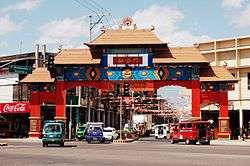
Davao Chinatown, also known as Mindanao Chinatown, is the only Chinatown in Mindanao located on the island's de facto capital, Davao City, Mindanao, Philippines. In 2003, then Mayor Rodrigo Roa Duterte issued an Executive Order declaring portions of Barangay 27-C and Barangay 30-C, where streets are mostly occupied by Filipino-Chinese with their respective businesses, as Davao City Chinatown and constituting the Davao City Chinatown Development Council (DCCDC). The creation of the DCCDC aims to assist in the active formulation and implementation of policies in an area that has great commercial, historical, economic and social significance to the Davao City.
Around 44 hectares, it is at the center of numerous business establishments, of which a great majority is owned by Chinese Filipinos who were either born in the country or naturalized Filipino citizens who trace their roots to mainland China. These business establishments include about 30 banks, a wide variety of restaurants offering not only Chinese cuisine but also Korean, Filipino and the like. Chinese themed malls and shops also pockmark this business enclave of the city of Davao which is globally known as the international gateway and most progressive city of Mindanao. It is the only Chinatown in The Philippines with its own seaport that is Sta. Ana Wharf.
Singapore

Singapore, a multi-racial, but predominantly Chinese, country has a relatively large Chinatown in a district to the south of the river originally designated for Chinese settlement by Sir Stamford Raffles. It remains known as Chinatown in English, and Niú chē shuǐ (牛车水, lit. 'ox cart water') in Chinese, and the MRT (rapid transit) station that serves the area is known by both names. The area around the station serves as a tourist attraction selling souvenirs, and also locally frequented areas including a number of traditional stores, markets, restaurants, apartment complexes, nightclubs, and Chinese temples including the Buddha Tooth Relic temple, and the Thian Hock Keng Temple. Festival markets also set up in the area during special events in the Lunar calendar such as the Chinese New Year or the Mid-Autumn Festival.
Chinatown is not exclusively Chinese; the Masjid Jamae and the Sri Mariamman Hindu Temple can also be found off the main street.
In 1989, several areas in Chinatown were earmarked by the Urban Redevelopment Authority as conservation areas. Under that programme, the historic streets of Kreta Ayer Road, Telok Ayer Street, Ann Siang Hill and Bukit Pasoh Road were restored. Because of its proximity to the administrative centre and the central business district, specialized professional and consultancy businesses as well as upmarket retail and dining establishments have displaced many traditional businesses in the historical shophouses in Chinatown.
- See also: Chinatown.SG
Thailand
Chinese Thais of Teochew (Chaozhou) descent are the dominant group of ethnic Chinese, with smaller numbers of those of Cantonese and Hakka origin as well. Rama I was the founder and the first monarch of the reigning House of Chakri of Siam His mother, Daoreung (original name Yok), was part-Chinese[12] Bangkok The Chinatown (Thai: Yaowarat) of Bangkok is located on Yaowarat Road and Sampeng Lane.
Phuket The city of Phuket is home to Thailand's second Chinatown, which are on Phang Nga Road, Thalang Road, Krabi Road, Phuket Road, Ratsada Road, Yaowarat Road, Deebook Road and Thepkrasattree Road Phuket was founded by early Chinese settlers.
Mae Salong There is a Chinese community in northern Thailand, in a town called Mae Salong near Myanmar. After the defeat and exile of Kuomintang from Mainland China by forces led by Mao Zedong, several Kuomintang army divisions in the Yunnan province fled into neighboring Myanmar. After being expelled from that country, the Mainland Chinese veterans fought Thai communists on behalf of the Thai government and were granted citizenship. Mae Salong was established by veterans of the Kuomintang army 93rd Division. Many of Thai-born Chinese generations have relocated to Taiwan, though their fathers and grandfathers, refuse because of an owed apology from the KMT for refusing them in the 1950s and 1960s. They have since made a retirement home-styled town, called "the home to the glorious people" (榮民之家) Today, Mae Salong is a spot for tourists from Taiwan and Mainland China.
Vietnam
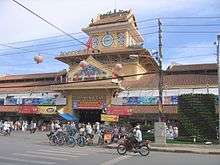
Ethnic Chinese have been moving to Vietnam for centuries. During the transition of power from Ming Dynasty to Qing Dynasty in China, many anti-Qing elements fled prosecution and came to Vietnam. To avoid angering the Qing government, Vietnam government decided to send them south to populate the scarcely populated area. They pioneered many settlements in the south of the country including Saigon (Sài Gòn - Vietnamese polyphonic version of the Cambodian name), or as it is known today, Ho Chi Minh City (Hồ Chí Minh). Ho Chi Minh City's Chinatown is the Cholon district which has been a stronghold for the Chinese-Vietnamese community since the late 1770s, when many Cantonese and Teochew Chinese arrived. Its main thoroughfares are Nguyen Trai Street (Nguyễn Trãi) and Tran Hung Dao Street (Trần Hưng Đạo). The Cholon area was the bastion of ethnic Chinese Vietnamese free enterprise until the Vietnamese communist government confiscated private property in the area.
Prior to Sino-Vietnamese War the Vietnamese government decided to expel the Sino-Vietnamese from the Northern part of the country hence the second wave of boat people many of whom went to China.
After the period of the Vietnam War and Sino-Vietnamese War (the late 1970s and early 1980s), many Chinese Vietnamese (called in Vietnamese the Viet Hoa) along with their ethnic Vietnamese, or the Viet Kinh, compatriots fled the country as "boat people". However, this third wave were mostly ethnic Vietnamese. As a result, there are many overseas Chinese Vietnamese communities in Australia, Canada, France, Germany, and the United States. Nevertheless, Vietnam still has a remnant ethnic Chinese community.
Discrimination and anti-Chinese sentiment
In 1997, the Asian financial crisis loomed over Asia and caused political turmoil, especially in Indonesia. Although several Southeast Asian leaders such as Malaysia's Prime Minister blamed the Western-dominated International Monetary Fund for the economic problems, many Indonesians took to the streets and blamed Chinese Indonesians who dominated the Indonesian economy for their economic woes. Angry Indonesian rioters destroyed Jakarta's Chinatown area, businesses run by ethnic Chinese, and homes throughout in the country.
External links
| Wikimedia Commons has media related to Chinatowns in Asia. |
- Chinatown.SG - Singapore Chinatown's official website
- http://www.chinatownology.com Singapore Chinatown
- Welcome to Hakka Community - Twilight descends on Calcutta's Chinatown
- Singapore's Chinatown
- The Chinatown of Malacca, Malaysia
References
- 1 2 Raitisoja, Geni " Chinatown Manila: Oldest in the world", Tradio86.com, July 8, 2006.
- ↑ "A Guide to Tokyo Chinatown".
- ↑ Kim, Hyung-jin (2006-08-29), "No 'real' Chinatown in S. Korea, the result of xenophobic attitudes", The Hankyoreh, Yonhap News, retrieved 2006-12-08
- ↑ Malaysian Electoral Commission ethnic composition of the state of Penang, 2008
- ↑ Malaysian Electoral Commission ethnic composition of the state of Sarawak, 2008
- ↑ Malaysian Electoral Commission ethnic composition of the state of Perak, 2008
- ↑ Malaysian Electoral Commission ethnic composition of the state of Sabah, 2008
- ↑ Malaysian Electoral Commission ethnic composition of the state of Malacca, 2008
- ↑ farik zolkepli. "Kuala Terengganu Chinatown a tourist draw - Malaysia | The Star Online". Thestar.com.my. Retrieved 2015-04-12.
- ↑ joseph kaos jr (2014-06-30). "Terengganu's unlikely tourist spots - Community | The Star Online". Thestar.com.my. Retrieved 2015-04-12.
- ↑ Chinatown (Karachi)
- ↑ First monarch of reigning House of Chakri of Siam was the son of a Siamese high court official and his part-Chinese wife.
